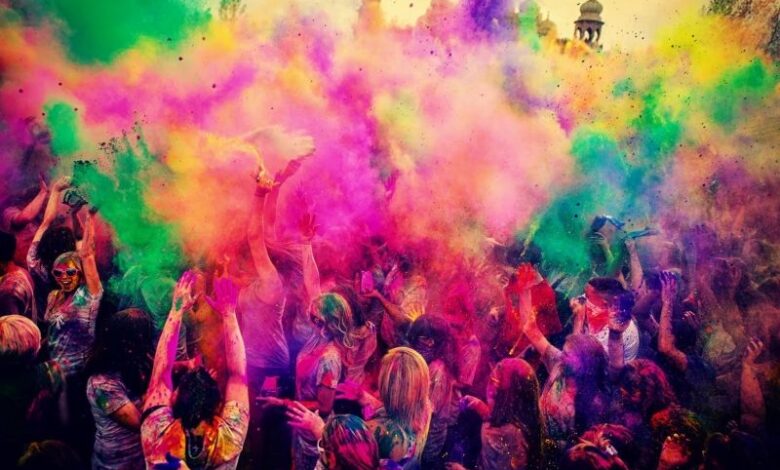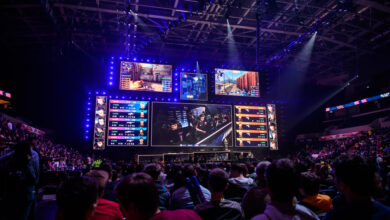
Holi Festival – A Short Guide on the Festival of Colors
The term Holi or Holi Festival may not mean much to you, but you may be familiar with the many breath-taking images from the “Festival of Colors“. Originally celebrated mainly in India, it is spreading in often modified forms all over the world and attracting many visitors. The bright colors, songs, dances, traditions, and simply the whole happy atmosphere fascinate people all over the world.
But do you actually know what the background behind this festival is? What is part of the tradition? Or why is it referred to as “the Indian Carnival”?
What and why is it celebrated?
Holi is one of the oldest festivals in India and Hindu culture. We also call it the Indian Spring Festival, the Festival of Love, or the Festival of Colors . In India, its name depends on the region, for example, in addition to Holi, it can also be called Shimga , Shigmo or Kamadahana . The length of the festival and the traditions or the way of celebrating also differ from region to region. However, it usually takes between two and ten days.
Holi is strongly linked to Hindu mythology and stories. The main celebration is the burning of the demoness Holika , through whose death good triumphed over evil. However, this is just one of the many fascinating stories surrounding Holi. Mentioning them all would fill an entire article by itself.
In nature, the victory of good over evil is seen through the onset of spring and the end of winter, hence the name Spring Festival. For this reason, Holi is also celebrated from the first full moon day of the month of Phalgun according to the Indian lunisolar calendar and is in February or March on our calendar.
Where is Holi Festival celebrated?
The festival originated in India. It is mainly celebrated there and in Nepal, as in both countries the majority of the population belongs to the Hindu faith. Otherwise, larger celebrations still take place in places with a large Indian population. These include Bangladesh, Pakistan, South Africa, Malaysia, USA, Canada and the Fiji Islands.
Some of these and other countries celebrate festivals that have evolved from Holi but no longer have much to do with the tradition behind it, just the fun, music and color.
Procedure, tradition and clothing of Holi Festival
On the first day of Holi, a fire is lit at night and a straw figure is burned in it, which is symbolic of the demon Holika. This ritual is usually associated with prayer and often takes place in public places such as parks. Traditional dishes such as gujiya are also prepared. Gujiya are sweet dumplings filled with different variations of dried fruit, nuts and cardamom. They are among the most typical dishes. On top of that, bhang, which is milk or yoghurt with cannabis flowers, has been a common toast for over 3,000 years .
From the second day, colour is literally brought to life. People throw colored water or the traditional powder, gulal, at each other. Water guns and water bombs are also often used. There is traditional music, songs, dances and drummers. Alcohol is actually forbidden, but this is increasingly being ignored when celebrating.
Another important tradition is the shedding of conflicts and disputes, because reconciliation should prevail on Holi.
There is no dress code for the Holi Festival. The women rarely wear green or red saris for traditional reasons. Instead, clothes are worn that can be ruined because the color usually cannot be washed out. Most of the time, white clothing is used, even if it never turns white again afterwards, because the color stands for truth and lets the bright colors shine.
Meaning of the powder “gulal”
The meaning behind the colored powder lies not only in mythology, but is primarily intended to cover up people’s skin color. This makes everyone look the same, which is why all class and gender boundaries are abolished on Holi in India. In the Iranian variation of the festival, called Nowruz , the citizens take over the “power” in symbolic acts for the period. This is comparable to the carnival and Mardi Gras in the United States, which is why Holi has also been given the nickname ” Indian Carnival “.
The colors used are also sacred and are still usually consecrated on an altar beforehand. At this ceremony, people often bring their blessings. In the past, the colors were made from plant substances such as flowers, roots and herbs with healing properties, but today they are often made from harmful, synthetic colors. It is always best to find out beforehand what color is used in a specific location.
The different colors also have meaning: red symbolizes love, fertility and honor, blue Krishna and green the new beginning.Hands with colored powder for Holi
The Holi Festival in India – See How Holi gets celebrated in different regions of India
There are variations in the celebrations by region, but the basic flow is always the same. South Delhi and its Holi Moo Festival is one of the best places to party especially for tourists. It is a modern form of the Holi festival featuring non-toxic paints, dance, music, street food and thandai , a yogurt drink with various spices.
In Udaipur, the most “luxurious” festival takes place. There is a spectacle with a royal band and decorated horses, later also drum players, singing, cocktails and dinner.
Varanasi has a special tradition when it comes to fire: everyone present rubs their bodies with a paste called ubtan and then throws it into the fire. They believe this will keep them healthy for the rest of the year. In addition, not only paint is thrown here, but also mud.
In Agra , Barsana , Vrindavan and Mumbai there is a tradition called Matki Phod . A pottery pot is filled with buttermilk or another milk product and hung in the street. Men then climb onto the shoulders and backs of others, forming a human pyramid. The man at the top then smashes the pot. To complicate matters, they are surrounded by women and girls singing, dancing and throwing colours.





